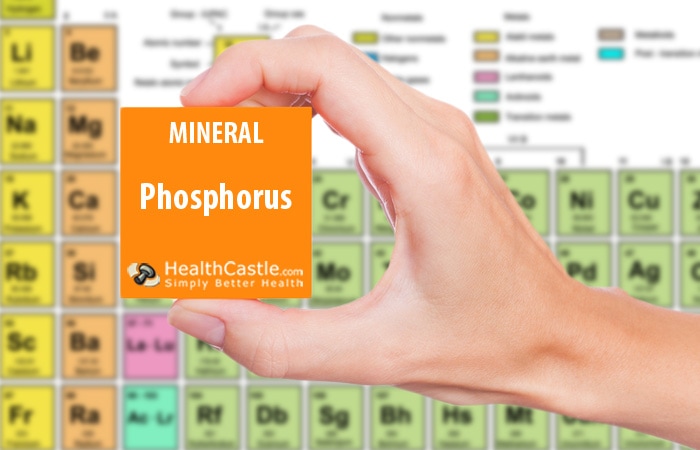
Written By: Carolyn Berry, RD
Title: Registered Dietitian
Alumni: University of British Columbia
Last Updated on:

Phosphorus is a mineral that is part of every cell in the body. About 85% of phosphorus in the body can be found in bones and teeth.
Table of Contents
The Dietary Reference Intakes (DRI) for phosphorus are shown below:
| Age Group | Recommended Dietary Allowance (RDA) per Day1 | Tolerable Upper Intake Level (UL) per Day 2* |
| Adults | ||
| 19 to 70 years | 700 mg | 4000 mg |
| 70 years and up | 700 mg | 3000 mg |
| Kids and Youth | ||
| 1 to 3 years | 460 mg | 3000 mg |
| 4 to 8 years | 500 mg | 3000 mg |
| 9 to 13 years | 1250 mg | 4000 mg |
| 14 to 18 years | 1250 mg | 4000 mg |
| Special Considerations | ||
| Pregnant women 14 to 18 years | 1250 mg | 3500 mg |
| Pregnant women 19 to 50 years | 700 mg | 3500 mg |
| Lactating women 14 to 18 years | 1250 mg | 4000 mg |
| Lactating women 19 to 50 years | 700 mg | 4000 mg |
*This includes sources of phosphorus from food and supplements

Phosphorus plays a critical role in the formation of bones and teeth. Next to calcium, phosphorus is the most abundant mineral in the body. These 2 important nutrients work closely together to build strong bones and teeth3.
Phosphorus is a primary component of ATP, a molecule the body uses to store energy. It also helps regulate many biochemical reactions by activating and deactivating enzymes4. Phosphorus works with potassium inside the cell to maintain proper fluid balance.
Phosphorus is needed for the growth5, maintenance, and repair of all tissues and cells, and for the production of the genetic building blocks, DNA and RNA. It is also a component of cell membranes.
Phosphorus also helps maintain normal acid-base balance (pH) by acting as one of the body’s most important buffers6. Additionally, phosphorus also plays a role in regulating oxygen delivery to the tissues of the body.
Dietary phosphorus deficiency is rare because it is so readily available in the food supply. Excessively high levels of phosphorus in the blood is also uncommon, but occur in those with advanced kidney disease or severe dysfunction of their calcium regulation.
Phosphorus-rich food sources are found in protein rich foods, such as meat, poultry, fish, eggs, dairy products, nuts, and legumes. Whole grains are also a source of phosphorus, and small amounts are found in fruits and vegetables.
| Food | Phosphorus per serving |
| Sardines, canned in oil, 3 oz | 442 mg |
| Pumpkin & squash seeds, without shell, 1/4 cup | 432 mg |
| Processed cheese slices, cheddar, 1.5 oz | 377 mg |
| All Bran cereal, 1 cup | 350 mg |
| Rice Bran, raw, 20 g | 335 mg |
| Scallops, cooked, 3 oz | 305 mg |
| Salmon, canned, 3 oz | 293 mg |
| Wheat bran, raw, 1/2 cup | 270 mg |
| Venison, tenderloin, roased, 3 oz | 269 mg |
| Milk, skim, 1 cup | 261 mg |
| Yogurt, plain, 3/4 cup | 261 mg |
| Cheddar cheese, 1.5 oz | 256 mg |
| Sunflower seeds, shelled, 1/4 cup | 241 mg |
| Pork, tenderloin, roasted, 3 oz | 230 mg |
| Cheese, brick, 1.5 oz | 226 mg |
| Buttermilk, 1 cup | 212 mg |
| Pine nuts, 1/4 cup | 197 mg |
| Oatmeal, cooked, 3/4 cup | 171 mg |
| Yogurt, flavoured, 3/4 cup | 167 mg |
In the United States: The Daily Value (DV) for phosphorus is 1,250 mg7 for ages 4 and older, which is higher than the RDA for adult males and females. The number you see on the Nutrition Facts label is a percentage calculated by dividing the amount of phosphorus in one serving of the food by the daily value. For example, 1/4 cup of pumpkin seeds, which contains 432 mg, has 35% of the daily value (DV) for phosphorus.
In Canada: The Daily Value for phosphorus is 1,250 mg8, which is more than the RDA for adult males and females. Using the same example as above, 1/4 cup of pumpkin seeds has 35% of the daily value for phosphorus. Listing the DV for phosphorus on the label is optional.
HealthCastle has strict sourcing guidelines. We reference peer-reviewed studies, scientific journals and associations. We only use quality, credible sources to ensure content accuracy and integrity.
Alumni: University of British Columbia – Carolyn Berry is a Vancouver-based Registered Dietitian, self-proclaimed foodie, marathon runner, and owner of Berry Nourished. Carolyn works in a variety of areas including clinical nutrition, outpatient counselling at Medisys Preventive Health Clinic, as a nutrition tour leader with Save-On-Foods, and in the media, including segments on CBC Television, CKNW and Spice Radio. Through informative and practical nutrition advice and her food-first approach to health, Carolyn fulfills her passion to empower others with knowledge about nutrition so that they can make the best decisions to improve their health. She strongly believes that food should be both healthful and delicious.
micronutrient - minerals, minerals, phosphorus